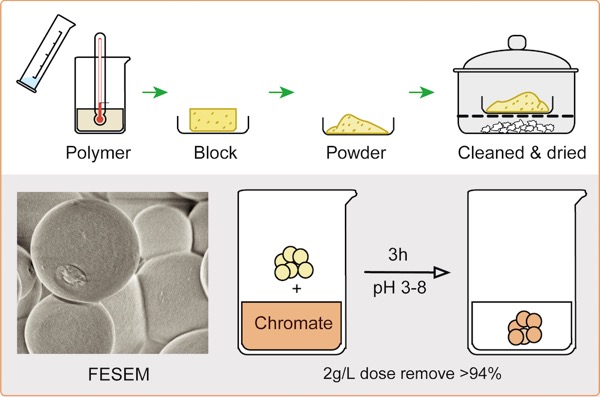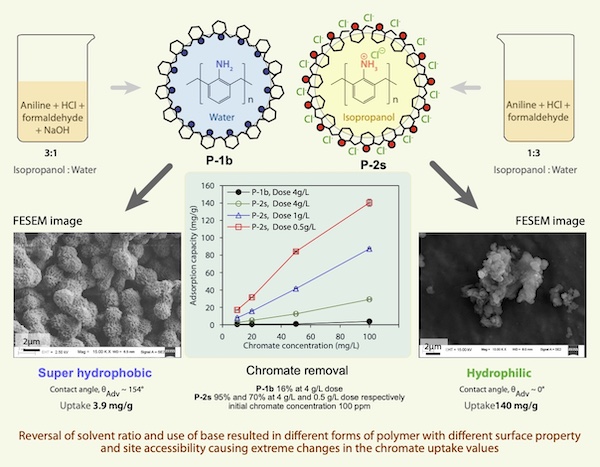Praisy Terangpi, Saswati Chakraborty*, and Manabendra Ray*
Chemical Engineering Journal 350 (2018) 599–607
In the past, removal of hexavalent chromium by aniline-formaldehyde condensate polymer coated on silica gel, showed poor removal at low concentration range (∼30% removal at 10 mg/L with a adsorbent dose of 8 g/L). The objective of the present study was to optimize the removal condition of Cr(VI) from very dilute solution (10 mg/L). Following on the initial experiments on modifying the synthesis of AFC, a new optimized form of the polymer has been synthesized by controlling solvent ratio and reaction conditions. The maximum removal of total chromium was observed between pH 3–8 (94–98% removal at 2 g/L dose, almost > 10 fold increase in efficiency). Field emission scanning Electron microscope (FESEM) showed polymer consists of micron-sized (1–2 μm diameter) clusters. Ion exchange as well as redox interaction between chromate ion and protonated amine group of polymer was found to be the key factor for adsorption. Overall, significant improvements observed in removal of Cr(VI). Material is effective over wider pH range. It is stable over 8 month in desiccator without losing activity.

Site orientation, accessibility, and surface hydrophobicity control on AFC polymer to increase hexavalent chromium removal performance
Tanmay Dutta and Manabendra Ray*
Chemical Engineering Journal, 2021, Accepted in October 30
In brief. AFC polymers with very different surface properties were synthesized by changing the solvent ratio. Salt forms remove chromate from water very efficiently without interference from common ions like Ca2+, Mg2+, Cl- and SO42-.
AFC is a polymer that has been shown to remove Cr(VI) efficiently (see our previous publications). Looking at the number of potential binding sites and the capacity determined by earlier experiments, we think many sites did not participate in the process. Site accessibility is a problem with many adsorbents. Here we focused on two aspects: orienting binding sites on the surface and changing the form of the functional group. We studied six different forms of polymer, varying the factors. The removal efficiency ranged from lowest to highest ever reported. We found both aspects contribute to the result, but not to the same extent. The significance of the results is not limited to AFC. It emphasizes the importance of site accessibility and the form of a functional group on the overall efficiency.
